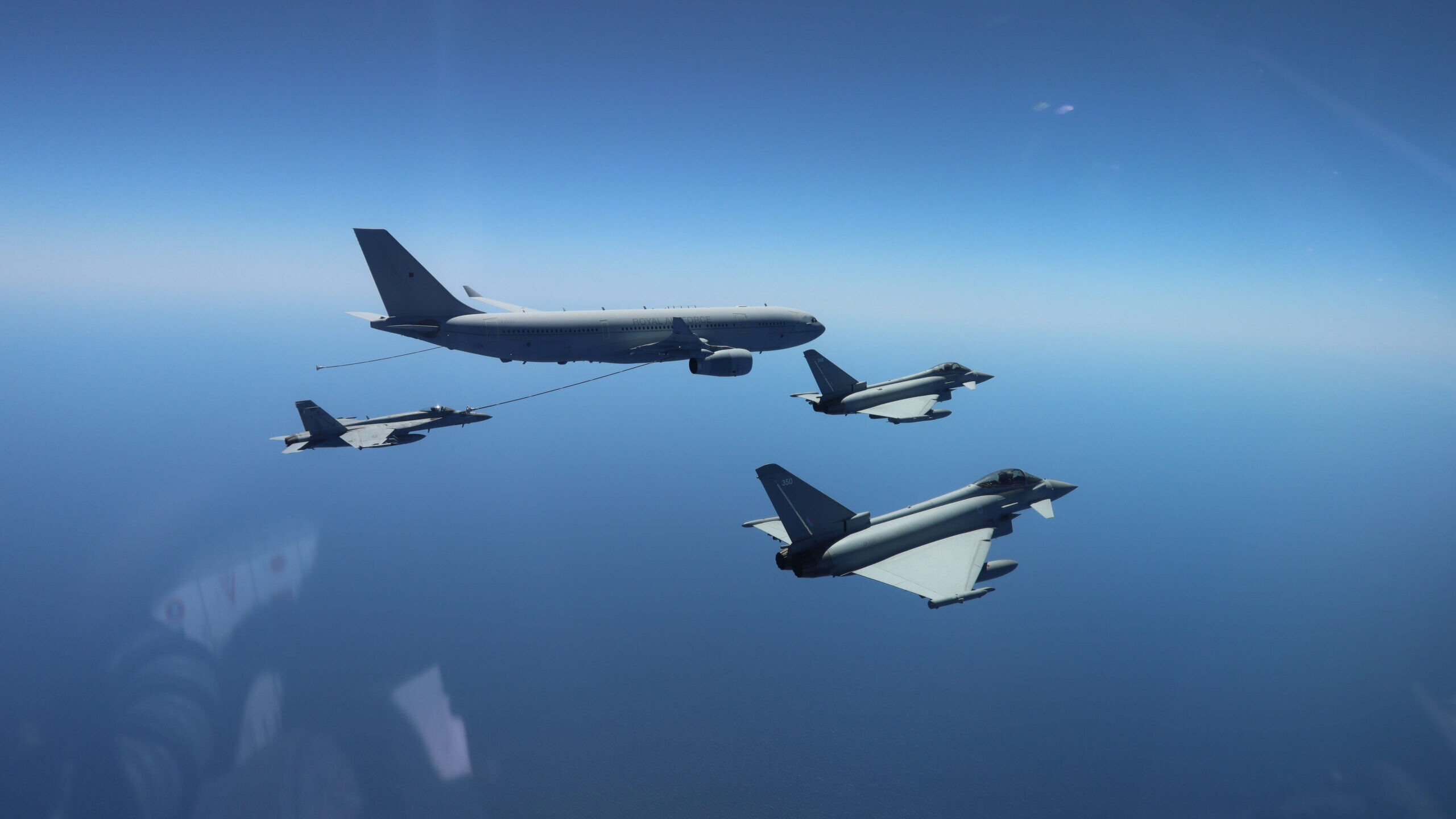
An F/A-18E Super Hornet, left, attached to the “Checkmates” of Strike Fighter Squadron (VFA) 211, receives fuel from a Royal British Air Force Airbus Voyager tanker-transport, center, alongside two Royal British Air Force Eurofighter Typhoons, in support of a Royal British Air Force bilateral exercise, April 14, 2022. (Photo courtesy of Strike Fighter Squadron 11)
WASHINGTON — England’s new offer to train Ukrainian fighter pilots may have whetted the appetite in Kyiv for a potential transfer of Western fighter jets, but a senior UK official said it was really about Ukraine’s “post-war” military — while also acknowledging having pilots familiar with Western fighters would be beneficial if the NATO nations begin supplying aircraft.
The decision was not, British Minister for Armed Forces James Heappey emphasized to reporters, an indication that Britain had decided to provide any fighter jets to Ukraine at this point. Instead, he said, it was driven by the fact that Ukraine had more fighter pilots than aircraft to fly, and that in discussions with his Ukrainian counterparts, they thought it be worthwhile to go ahead and train the pilots up on Western aircraft.
“Well, maybe we could start to disperse these people around the world just starting to learn to fly different sort of NATO-type planes, but that is principally with a view to a post-war Ukrainian Air Force that will inevitably be re-armed with NATO-type planes,” Heappey said while visiting Washington.
“But, of course, you’ve always got an eye on what the next gear change might need to be if the war continues to develop and another gear change is needed,” he added. “And so in six months time, if that gear change is fast jets, then clearly having started the process of training pilots and engineers, makes that an easier choice to make.”
RELATED: What Ukraine wants from France: Munitions, training, air defense and, maybe, fighter jets?
The British government made headlines Wednesday when it announced, ahead of a visit by Ukrainian President Volodymyr Zelenskyy, that London would offer to provide training for Ukrainian fighter pilots. Prime Minister Rishi Sunak pushed further when he said later in the day that he’d asked Defence Secretary Ben Wallace to look into what kinds of aircraft could be supplied to Ukraine.
“The training will ensure pilots are able to fly sophisticated NATO-standard fighter jets in the future,” Sunak’s office said at the time.
At a press conference today in Brussels, Zelenskyy suggested several European leaders may be willing to provide aircraft to his military.
“Europe will be with us until our victory. I’ve heard it from a number of European leaders… about the readiness to give us the necessary weapons and support, including the aircraft,” he said, according to Reuters.
The Ukraine Air Force currently operates Su-24, Su-25 and MiG-29 Soviet-era fighter jets, but Zelenskyy has long called on equipment supply partners to gift fighters to his beleaguered air forces.
The RAF fighter jet fleets are made up of Eurofighter Typhoon and F-35 aircraft. Realistically, only the Typhoons are likely to be part of any Ukraine training considerations as some are in storage or set for retirement, while only one UK F-35 squadron has so far been stood up — and there is no chance the US or its allies would send the highly-advanced fighter into Ukraine.
Textron, Leonardo bank on M-346 global experience in looming race for Navy trainer
“The strength we think we bring is that [the Navy is] going to go from contract to actually starting to turn out students much quicker than any other competitors,” a Textron executive told Breaking Defense.


























